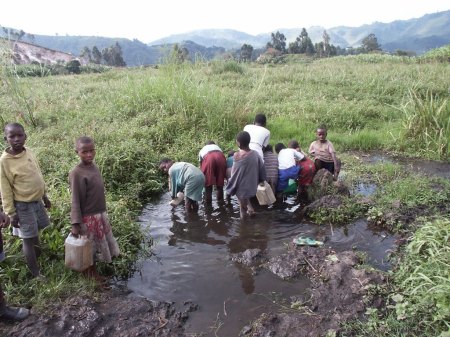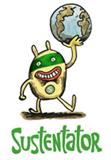In respect to this week’s Photo of the Week of Andy Shirey celebrating with youngsters positively affected by The Water School, I thought it only appropriate to share a recent interview that I had with one of the non-profit’s creators, Bob Dell.
An inspiring organization, The Water School, is based on an easy-to-use water cleansing system that is saving thousands of lives. The simple purification water bottle device has literally brought a new chance for a healthy life to children around the world.
 children looking forward to a happy future because of The Water School, photo courtesy of Andy Shirey
children looking forward to a happy future because of The Water School, photo courtesy of Andy Shirey
EoC: How did the original concept of The Water School come about?
BD: Fraser Edwards and I had collaborated on clean water projects together in East Africa for approximately six years and realized that the largest component of our work was “education”. Many NGOs were drilling wells or providing other sources of water. Some were introducing complex systems to treat contaminated water. Relatively few however, were providing a knowledge base and teaching the beneficiaries to use local skills and resources to meet their own clean water needs on a sustainable basis. The Water School was born out of this need.
 typical drinking water
typical drinking water
source in rural areas where The Water School works
 The moment Bob Dell realized the children were drinking
The moment Bob Dell realized the children were drinking
water from a swamp loaded with animal fecal matter. It inspired him to do
this work.
EoC: As the non-profit was started by you and Fraser, collaboration was involved from the beginning. In what ways did working together help The Water School become what it is today?
BD: Fraser had many years of experience in implementing community development programs in East Africa and I had over 40 years experience in water and waste water treatment processes in Canada. We were able to leverage each others experience to find simple, inexpensive and sustainable systems like solar disinfection to treat contaminated water and also implement partnerships that were already in place in local communities. By teaching the educated level of the community and in turn taking the programs to the schools, students are made aware of the importance of health, sanitation and clean drinking water. They are also shown the tools they already have available to clean their water and are then able to take this information home and teach their families.
 This is one of Bob’s favorite photos. A lot of
This is one of Bob’s favorite photos. A lot of
these children are orphans without clean drinking water (The Water School was able to
change that). A very moving experience for Bob, the kids thought his name was Bobba which means father, and they
didn’t want to leave.
EoC: How did your background in business assist the development of the non-profit?
BD: Fraser came from an entrepreneurial business background in Western Canada before moving into overseas work. I was President and owner of a consulting and research laboratory in Ontario before deciding to retire and help children in developing countries get clean water. Both of us realized that an NGO must be run in a business-like and accountable fashion to its donors and that local ownership of implementation programs was quintessential to success.
EoC: What is the most important personality trait for positive collaboration, in your opinion?
BD: It is certainly important to let go of ego. No one yet has the perfect answer and it is important to listen and learn from the mistakes and successes of others. Even though the implementation model has been very successful, The Water School recognizes that each culture is different and the teaching and support process in any new area must be linked closely to those on the ground that understand the cultural differences.
EoC: The Water School is assisting Haiti with water issues after the devastating earthquakes. In what ways is this situation more challenging?
BD: Most areas that we work in are poverty stricken and so was Haiti before the earthquake (we were already planning an implementation program before it happened). The infrastructure of the country has been devastated (90% of the schools have been destroyed). Our challenge is to work with individuals in Haiti like Dr. Bibiana MacLeod who can deal with the trauma and the structural damage and still inspire people to take ownership of their own problems including clean drinking water.
EoC: One of the basic principles of The Water School is to work with the children first, and the adults learn through them. What have you learned about collaboration from the kids that you are working with?
BD: When we first decided to take the solar disinfection program to the children, we were told that drinking water from a bottle was not part of the culture and the children would not do it. To the contrary, the children embraced the concept and thought it was fun. In fact, they taught us some things about culture and have taken the lead in delivering the knowledge of safe drinking water to their families. Nothing inspires a mother more than a previously sick child that is now healthy.
 Anne, the first mother to embrace The Water School process, has changed the lives of her children and taught it to her neighbors. She has been responsible for saving many lives in her community.
Anne, the first mother to embrace The Water School process, has changed the lives of her children and taught it to her neighbors. She has been responsible for saving many lives in her community.
EoC: What is your biggest obstacle in advancing the positivity that The Water School is creating?
BD: Our solar disinfection process is simple and that has been the foundation of its success. We still have people who do not believe that such a simple process can work but several hundred thousand people in the areas we have worked in will disagree. Our biggest obstacle is having people (at the user end and the donor end) believe that simple does work.
 The Water School purification process in action
The Water School purification process in action
EoC: Please share an experience that came from the positivity created by The Water School.
BD: In Kisoro, Uganda, there is a hospital that was built 20 years ago specifically to treat patient dysentery from contaminated water. Close to 20% of children under the age of five at that time died from water borne disease. Over the years, the hospital had grown to include wings for maternity, HIV/AIDS, malaria, etc but the dysentery wing remained. As we introduced our clean water programs in this area beginning in 2001, the water borne disease cases dropped dramatically on an annual basis and in the summer of 2007, the dysentery wing of the hospital was closed. It is now a nurse’s residence.
 The Dysentery Wing turned Nurses Residence
The Dysentery Wing turned Nurses Residence
EoC: In addition to funding, are there other ways that people can become involved?
BD: We do need funding to expand our programs but there are other needs. People who have traveled to our projects in Africa have returned home and become advocates. They are spreading the word to others within their organizations, schools, churches, etc. We see a growing need for teachers and educational experts in a volunteer capacity as we take our program to other NGOs and help them take it to the field.
 children hauling contaminated water 4 kilometers before The Water School helped them have another option
children hauling contaminated water 4 kilometers before The Water School helped them have another option
EoC: What would you say to those contemplating creating a collaborative non-profit organization?
BD: First and foremost, develop a deep passion and a vision for helping those in need to get safe drinking water. We have been driven by this since the beginning. Second, learn what works and doesn’t work. Many NGOs are well intentioned but not knowledgeable. This wastes resources and time. Above all else, The Water School is about sharing knowledge.
EoC: Where do you see The Water School in the future?
BD: We have expanded dramatically in the past three years. Water School programs are now running in Uganda, Kenya and Sudan. We will be introducing the program in Haiti, Cameroon and Bolivia in the coming months. Our plan is to utilize the Internet to the maximum extent to deliver our knowledge on providing simple clean drinking water. We have our teacher’s training manual on our website in three languages and three more are ready. Our hope is to have it translated and available on the web in as many languages as there are different children in need of safe drinking water.
 These are kids whose health, school
These are kids whose health, school
attendance and school marks changed dramatically with clean water. Do
you think they will let their children die from contaminated drinking
water?





At First I did not believe the simple SODIS method as compared to other complex methods of water treatment. But through the Training and imperical proof that TWSU uses, I strong believe and embrace the activities of the TWS. It is not expensive, only involves use available resources. Am absolutely taking this home. God bless TWS.
By: LT Dauda on May 11, 2010
at 9:10 AM
Thanks LT Dauda for your comment. Yes, what TWS is doing is so incredibly important.
Cheers,
Shanie
By: Shanie Matthews on May 11, 2010
at 10:01 AM